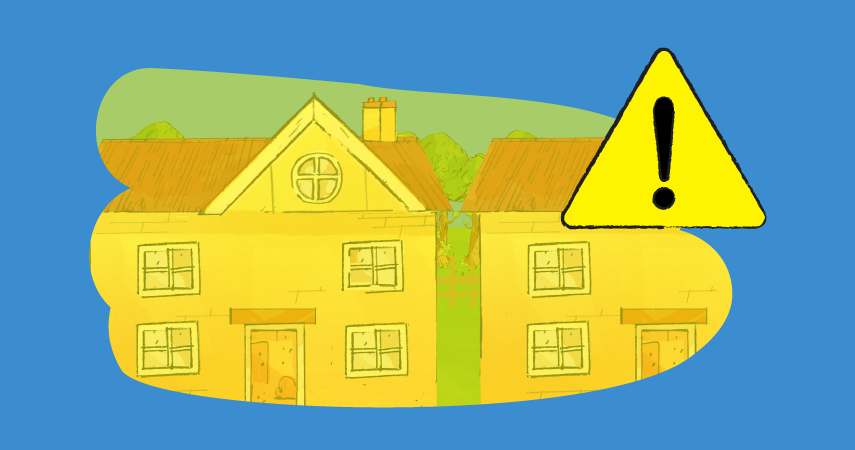A landlord’s guide to asbestos awareness

If you’ve invested in or plan to invest in an older property, then there could be a hidden health risk in your midst – asbestos. This could be an important issue that landlords should make themselves aware of. Read on to learn more about asbestos in rental properties.
What is asbestos?
Asbestos is an umbrella term that refers to several naturally occurring fibrous minerals. There are two different categories that asbestos falls into – serpentine and amphiboles. Under these categories, three types of asbestos were primarily used in building materials:
- Chrysotile (white asbestos)
- Amosite (brown asbestos)
- Crocidolite (blue asbestos)
While once widely used, brown and blue asbestos were banned in the UK in 1985, followed by white asbestos in 1999. This complete ban in 1999 made it illegal in the UK to buy, sell, import or export any materials that contain asbestos.
Asbestos was especially common as a building material between the 1950s and 1980s, but may be present in any properties built before the year 2000. If you are the landlord of a property built before the year 2000, you should, therefore, be especially vigilant and ensure you have a good awareness of the risks.
What are the health hazards of asbestos?
Prior to it being banned in 1999, asbestos was widely used because people were simply unaware of the health hazards it created. This was perhaps because the onset time of asbestos-related illnesses (asbestosis and mesothelioma) can be anything from 10 to 40 years, or even longer, after the initial exposure. So, at the time, people weren’t experiencing any immediate symptoms of ill-health.
However, this means that some of the people who were regularly exposed to asbestos fibres in the 1970s may have only recently begun to experience the harmful after-effects. All these decades later, approximately 5,000 people die each year in the UK from cancers caused by inhaling asbestos fibres.
How does asbestos cause ill health?
The presence of asbestos in a property isn’t necessarily an immediate cause for concern. This is because when the material is intact and undisturbed, it poses very little risk. It is only when the asbestos-containing material is damaged or disturbed that it becomes a serious threat, as this causes the fibres to be released into the air.
Asbestos causes harm to people’s health when the fibres are inhaled. A singular, short exposure to asbestos is unlikely to do you much damage, but regular or prolonged exposure to the harmful fibres has the potential to cause serious problems further down the line.
The fibres can be released by all kinds of activities, such as drilling holes in the wall, knocking down walls or removing plasterboard. If you suspect that asbestos may be present in your rental property and you plan to carry out work, then it’s important that you assess the risks first.
Where is asbestos found in rental properties?
Although its use was banned in the UK, its presence in buildings that already contained it before the ban is not illegal, although highly regulated. As a result, asbestos-containing materials still widely exist in buildings and products installed before the year 2000.
Asbestos was used extensively because it possesses many ideal properties. Amongst other things, asbestos is strong, incombustible, heat-resistant, cheap, sound absorbent and can control condensation. It could be used to make all sorts of products – from roof tiles to kitchen paper – making it easy to see why it was so popular.
In a rental property, asbestos may be found in almost any material. Some of the most common locations include:
- Textured wall and ceiling coatings, such as Artex
- Floor tiles
- Insulation materials
- Fire blankets and fire doors
- Roof felt
- Guttering and pipework
- Bath panels
- Garage roofs
What are landlords’ legal responsibilities?
As mentioned, the presence of asbestos in older buildings is highly regulated. Let’s look at some of the laws and regulations that landlords should be aware of.
Other regulations relevant to asbestos control
While the below regulations don’t specifically refer to asbestos, they could apply if the improper identification, handling and maintenance of asbestos could cause health hazards to your tenants.
Under the Housing Act 2004, landlords have a responsibility to identify and evaluate threats according to the Housing Health and Safety Rating System, a system which specifically mentions asbestos as a health hazard. The Landlord and Tenant Act 1985 states that landlords must maintain the structure and exterior of the property. So, it is your duty to both identify and maintain asbestos properly.
The Defective Premises Act 1972 applies if you built your rental property yourself. This regulation reiterates the importance of protecting tenants from personal injury or disease caused by a defect in the state of the property. Similarly, the Homes (Fitness for Human Habitation) Act 2018 states that landlords must ensure their rental properties are fit for human habitation, and improperly maintained asbestos could make a home uninhabitable.
The Control of Asbestos Regulations
Under the Control of Asbestos Regulations 2012 (CAR 2012), employers and the self-employed must prevent people from being exposed to asbestos or else reduce the risk to as low a level as possible.
These regulations apply to landlords, but the law only refers to ‘non-domestic’ properties. This means that you have a legal responsibility to assess the risks from asbestos in all common parts where people don’t live, such as entrance halls, stairways, shared roof spaces, shared garages, boiler rooms and communal gardens.
The law requires you to find out if asbestos is present in these communal parts and protect people from the hazards. If you locate asbestos-containing materials, then you should make a record of the location and type of asbestos and ensure a plan is in place to manage the risks and monitor any changes in its condition.
If you intend to instruct tradesmen to work on your property, then you should inform them of the presence of asbestos (or suspected presence) before they begin work.
Under CAR 2012, private residences like individual flats, private houses and private rooms are not covered by the same requirements, and so you don’t have a ‘duty’ to manage asbestos risks. However, it may still be good practice to assess the risks in order to keep your tenants from harm.
What should you do if you suspect asbestos is present?
If you, a tenant, or a tradesman suspect that asbestos may be present in the property, then your first step is to leave it alone. Disturbing or trying to move the asbestos can cause harmful fibres to be released, so it’s important that you don’t try and remove it yourself.
Inform your local authority of your suspicions and arrange for the material to be tested and/or removed by a licensed contractor if necessary.
If the asbestos is in good condition and hasn’t been damaged or disturbed, then it’s safe to leave it in situ. Simply label the material as ‘contains asbestos’ and make a note of its location for future reference.
If the asbestos is in poor condition (either damaged or disturbed) then it should be removed by a licensed asbestos removal company. Never try to remove asbestos-containing materials yourself.
If you think that you, a tenant, or a tradesman has been exposed to asbestos fibres, or if someone has developed ill health as a result of exposure, then it is essential that they see a doctor straight away.
Find suitable protection for your property
There are various risks associated with letting a residential home. Help keep your investment safe, whether it’s a single property or a portfolio. Our comprehensive Landlord Insurance can help protect you from financial risks, including accidental and malicious damage by tenants and loss of rent if the property becomes uninhabitable due to an insured event.
The sole purpose of this article is to provide guidance on the issues covered. This article is not intended to give legal advice, and, accordingly, it should not be relied upon. It should not be regarded as a comprehensive statement of the law and/or market practice in this area. We make no claims as to the completeness or accuracy of the information contained herein or in the links which were live at the date of publication. You should not act upon (or should refrain from acting upon) information in this publication without first seeking specific legal and/or specialist advice. Arthur J. Gallagher Insurance Brokers Limited trading as Just Landlords accepts no liability for any inaccuracy, omission or mistake in this publication, nor will we be responsible for any loss which may be suffered as a result of any person relying on the information contained herein.
FP1747-2023




